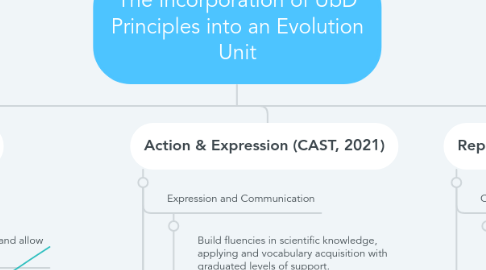
1. Engagement (Cast, 2021)
1.1. Sustaining Effort
1.1.1. Menu Boards- vary demands and allow students to be challenged
1.1.2. Foster Collaboration- Think Pair Share as reflection activities- I plan on using this method after introducing new concepts in a traditional format (teacher led instruction). The students can reflect and share their knowledge of the topic with their peers.
1.1.2.1. Think-Pair-Share activities allow students to utilize previously learned knowledge and can replace the need for a more formal assessment (Demirci & Duzenli, 2017).
1.2. Recruiting Intrest
1.2.1. Individualized Choice
1.2.1.1. The use of Menu Boards or Choice Boards: Each student has to achieve a set value. For example, 10, of which the student can pick 5 level 2 activities or 3 level 3 activities with 1 level 1 etc. Higher valued activities are increased in rigor.
1.2.1.1.1. Engagement activities like menu boards allow for different perceived challenges (CAST, 2021).
1.2.2. Common Fallacies
1.2.2.1. Students typically think they understand evolution before the first lesson starts. One way I plan on generating interest in the topic is by debunking the common misconceptions and building an understand of Evolution with it's actual definition.
2. Action & Expression (CAST, 2021)
2.1. Expression and Communication
2.1.1. Build fluencies in scientific knowledge, applying and vocabulary acquisition with graduated levels of support.
2.1.1.1. Instruction gradually escalates up in rigor and results by giving direct instruction, then leading scientific inquiry before allowing the students to form their own conclusions based on gathered evidence.
2.2. Executive Functions
2.2.1. Facilitate managing information & resources
2.2.1.1. Use Cornell notes to present teacher led direct instruction- Cornell note taking is a strategy of writing then reflecting on your notes. It allows for both knowledge attainment and reflection and can serve as a valuable study tool for students.
2.2.1.1.1. Students who use Cornell notes taking show an increase in comprehension of the subject (Ahmed, 2019).
2.3. Physical Actions
2.3.1. Provide software incorporated into online course framework to allow for customizations such as closed captions, backgrounds, overlays and font size
2.3.2. Students will demonstrate comprehension by playing "Bio-rades- Evolution Edition", where each student acts out a key concept or term used in an effort to win bonus points on the formal assessment for their team. Based on charades, students can not talk and must think in unconventional ways to display the concepts or definitions.
3. Representation (CAST, 2021)
3.1. Customizing display
3.1.1. Students can use online platform to choose format, text, color and size of text, presentations and assignments
3.1.2. Students will demonstrate comprehension by completing a texting story ( we are a 1:1 iPad district). This app make a video of a series of text messages. Students will use the view point of descent with modification and natural selection, and form a pretend discuss with another person who believes in acquired characteristics (a Lamarkian view with no evidence).
3.2. Customizing auditory
3.2.1. Students can use online platform (Canvas in my district) to add closed captions to videos or use text to speech to change the volume, accent and speed for text that is computer generated to be read out loud.
